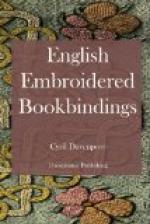[Illustration: 33—Bible. Cambridge, 1674.]
Bible. Cambridge, 1674.
A large Bible printed at Cambridge in 1674, in two volumes, was bound in crimson velvet for James II., presumably about 1685. The work upon it, each volume being the same, is of a showy character, good and strong, but utterly wanting in any of the artistic qualities either of design or execution which characterised so many of the earlier examples. In the centre are the initials ‘J. R.’ surmounted by a royal crown, heavily worked in gold braid, guimp, and some coloured silks. Enclosing the initials and crown are scrolls in thick gold twist; these again are surrounded by a curving ribbon of gold, intertwined with roses and leafy sprays. In each corner is a silver-faced cherub with beads for eyes and gold wings, and at the top a small blue cloud with sun rays, tears dropping from it. There are two broad silk ties to the front of each board, heavily fringed with gold.
The back is divided into nine panels, each containing an arabesque ornament worked in gold cord and thread, the first and last panels being larger than the others and containing a more elaborate design. The edges of the leaves are simply gilt, and the boards measure 18 by 12 inches each, the largest size of any embroidered book known to me.
CHAPTER IV
BOOKS BOUND IN SATIN
Collection of Sixteenth-Century Tracts. Bound probably about 1536.
[Illustration: 34—Collection of Sixteenth-Century Tracts.]
Perhaps the earliest existing English book bound in satin is a collection of sixteenth-century tracts that belonged to Henry VIII., and is now part of the Old Royal Library in the British Museum. It is covered in red satin, measures 12 by 8 inches, and is embroidered in an arabesque design, outlined with gold cord. On the edges the words ‘Rex in aeternum vive Neez’ are written in gold. The word ‘Neez’ or ‘Nez,’ as it is sometimes spelt, may mean Nebuchadnezzar, as the other words were addressed to him. On books bound in leather by Thomas Berthelet, royal binder to Henry VIII. and his immediate successors, the motto often occurs, and as he is known to have bound books in ‘crymosyn satin,’ this is most likely his work. The pattern is worked irregularly all round the boards, and a sort of arabesque bridge crosses the centres. The back is new, and of leather, but the boards themselves are the original ones, and the embroidery is in a very fair condition.
[Illustration: 35—New Testament in Greek. Leyden, 1570.]
New Testament in Greek. Leyden, 1576.




